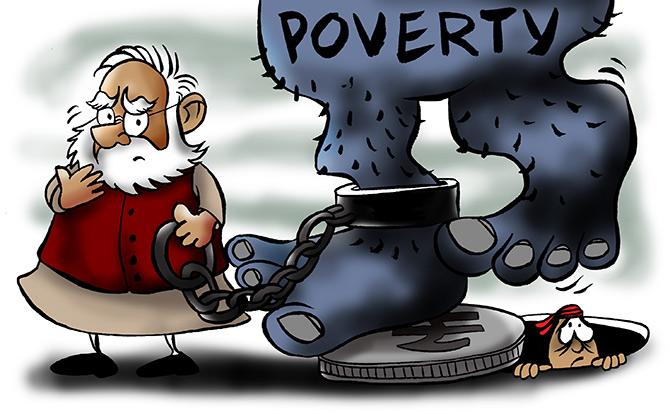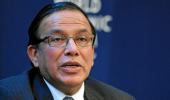Bihar, Jharkhand and Uttar Pradesh have emerged as the poorest states in India, according to Niti Aayog's first Multidimensional Poverty Index (MPI) report.

As per the index, 51.91 per cent population of Bihar is poor, followed 42.16 per cent in Jharkhand, 37.79 per cent in Uttar Pradesh.
While Madhya Pradesh (36.65 per cent) has been placed fourth in the index, Meghalaya (32.67 per cent) is at the fifth spot.
Kerala (0.71 per cent), Goa (3.76 per cent), Sikkim (3.82 per cent), Tamil Nadu (4.89 per cent) and Punjab (5.59 per cent) have registered the lowest poverty across India and are at the bottom of the index.
Among Union territories (UTs), Dadra and Nagar Haveli (27.36 per cent), Jammu & Kashmir, and Ladakh (12.58), Daman & Diu (6.82 per cent) and Chandigarh (5.97 per cent), emerged as the poorest UTs. Puducherry having 1.72 per cent of its population as poor, Lakshadweep (1.82 per cent ), Andaman & Nicobar Islands (4.30 per cent) and Delhi (4.79 per cent) have fared better.
Bihar has the highest number of malnourished people followed by Jharkhand, Madhya Pradesh, Uttar Pradesh and Chhattisgarh.
Bihar is also the worst performer when it comes to percentage of population deprived of maternal health, percentage of population deprived of years of schooling, school attendance and percentage of population deprived of cooking fuel and electricity.
Uttar Pradesh ranked the worst in child and adolescent mortality category, followed by Bihar and Madhya Pradesh, while Jharkhand performed the worst when it comes to percentage of population deprived of sanitation, followed by Bihar and Odisha.
According to the report, India's national MPI measure uses the globally accepted and robust methodology developed by the Oxford Poverty and Human Development Initiative (OPHI) and the United Nations Development Programme (UNDP).
Importantly, as a measure of multidimensional poverty, it captures multiple and simultaneous deprivation faced by households, it added.
The report said India's MPI has three equally weighted dimensions, health, education and standard of living - which are represented by 12 indicators namely nutrition, child and adolescent mortality, antenatal care, years of schooling, school attendance, cooking fuel, sanitation, drinking water, electricity, housing, assets and bank accounts.
The Sustainable Development Goals (SDG) framework, adopted by 193 countries in 2015, has redefined development policies, government priorities, and metrics for measuring development progress across the world.
The SDG framework, with 17 global goals and 169 targets, is significantly wider in scope and scale relative to the Millennium Development Goals (MDG), its predecessor.
Niti Aayog vice chairman Rajiv Kumar in his foreword said, "The development of the National Multidimensional Poverty Index of India is an important contribution towards instituting a public policy tool which monitors multidimensional poverty, informs evidence-based and focused interventions, thereby ensuring that no one is left behind."
Kumar further said this baseline report of India's first ever national MPI measure is based on the reference period of 2015-16 of the National Family Health Survey (NFHS).
The national MPI measure has been constructed by utilising 12 key components which cover areas such as health and nutrition, education and standard of living, he said.
Niti Aayog CEO Amitabh Kant in his foreword said the year 2021 marks the sixth anniversary of the adoption of the Sustainable Development Goals which envisage ending poverty in all its forms everywhere.
"Steered by the government of India's Global Indices for Reforms and Growth (GIRG) initiative, the National Multidimensional Poverty Index (MPI) for India is aimed at leveraging the monitoring mechanism and methodology of the globally recognised MPI to rigorously benchmark national and subnational performance and drive programmatic actions and reforms," Kant said.
He said India's national MPI highlights the need for a whole-of-government approach towards addressing poverty and its multidimensionality.
The report said the national MPI, an aggregate measure which defines poverty, in simple terms, as the deprivation in crucial and basic parameters of health, education, and living standards, is a significant departure from the way poverty has been understood and conceptualised historically.
"While this report is an indispensable first step in mainstreaming MPI, it is based on a dataset which is five years old.
"The success of numerous development interventions in the recent past have resulted in progress in key parameters on health, education, and standard of living," it added.
In early 2020, the Cabinet Secretariat, Government of India, identified 29 global indices to monitor, analyse and evaluate with the aim of improving India's position in global rankings.
Under this mandate, also known as the Global Indices for Reforms and Growth (GIRG) mandate, Niti Aayog was identified as the nodal agency for the Multidimensional Poverty Index (MPI).











 © 2025 Rediff.com -
© 2025 Rediff.com -